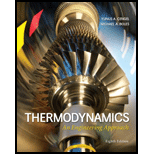
(a)
The critical temperature of air.
The critical pressure of air.
The critical density of air.
(a)
Answer to Problem 38P
The critical temperature of air is
The critical pressure of air is
The critical density of air is
Explanation of Solution
Write the formula to calculate the stagnation temperature of ideal gas.
Here, the static temperature of ideal gas is
Write the formula to calculate the stagnation pressure of ideal gas.
Here, the static pressure of ideal gas is
Write the formula to calculate the density of the ideal gas.
Here, the pressure of the ideal gas is
Write the formula to calculate the critical temperature at the throat of nozzle.
Here, the stagnation temperature of ideal gas is
Write the formula to calculate the critical pressure at the throat of nozzle.
Here, the stagnation pressure of ideal gas is
Write the formula to calculate the critical density at the throat of nozzle.
Here, the stagnation density of ideal gas is
Conclusion:
Refer Table A-2, “Ideal-gas specific heats of various common gases” to obtain value of universal gas constant, specific heat of pressure, and the specific heat ratio of air at
Substitute
Substitute 200 kPa for
Substitute
Substitute
Thus, the critical temperature of air is
Substitute
Thus, the critical pressure of air is
Substitute
Thus, the critical density of air is
(b)
The critical temperature of helium.
The critical pressure of helium.
The critical density of helium.
(b)
Answer to Problem 38P
The critical temperature of helium is
The critical pressure of helium is
The critical density of helium is
Explanation of Solution
Conclusion:
From the Table A-2, “Ideal-gas specific heats of various common gases” to obtain value of universal gas constant, specific heat of pressure, and the specific heat ratio of helium at
Substitute
Substitute 200 kPa for
Substitute 214.2 kPa for
Substitute
Thus, the critical temperature of helium is
Substitute
Thus, the critical pressure of helium is
Substitute
Thus, the critical density of helium is
Want to see more full solutions like this?
Chapter 17 Solutions
Thermodynamics: An Engineering Approach
- HW12 A multiple-disc clutch has five plates having four pairs of active friction surfaces. If the intensity of pressure is not to exceed 0.127 N/mm², find the power transmitted at 500 r.p.m. The outer and inner radii of friction surfaces are 125 mm and 75 mm respectively. Assume uniform wear and take the coefficient of friction = 0.3.arrow_forwardThe sketch below gives some details of the human heart at rest. What is the total power requirement (work/time) for an artificial heart pump if we use a safety factor of 5 to allow for inefficiencies, the need to operate the heart under stress, etc.? Assume blood has the properties of water. p pressure above atmosphere blood going to the lungs for a fresh charge of oxygen p = 2.9 kPa 25v pulmonary artery d = 25mm fresh oxygenated blood from the lungs p = 1.0 kPa vena cava d=30mm right auricle pulmonary vein, d = 28mm aorta, d=20mm spent blood returning from left auricle the body p = 0.66 kPa right left ventricle ventricle blood to feed the body, p 13 kPa normal blood flow = 90 ml/sarrow_forward4- A horizontal Venturi meter is used to measure the flow rate of water through the piping system of 20 cm I.D, where the diameter of throat in the meter is d₂ = 10 cm. The pressure at inlet is 17.658 N/cm2 gauge and the vacuum pressure of 35 cm Hg at throat. Find the discharge of water. Take Cd = 0.98.arrow_forward
 Elements Of ElectromagneticsMechanical EngineeringISBN:9780190698614Author:Sadiku, Matthew N. O.Publisher:Oxford University Press
Elements Of ElectromagneticsMechanical EngineeringISBN:9780190698614Author:Sadiku, Matthew N. O.Publisher:Oxford University Press Mechanics of Materials (10th Edition)Mechanical EngineeringISBN:9780134319650Author:Russell C. HibbelerPublisher:PEARSON
Mechanics of Materials (10th Edition)Mechanical EngineeringISBN:9780134319650Author:Russell C. HibbelerPublisher:PEARSON Thermodynamics: An Engineering ApproachMechanical EngineeringISBN:9781259822674Author:Yunus A. Cengel Dr., Michael A. BolesPublisher:McGraw-Hill Education
Thermodynamics: An Engineering ApproachMechanical EngineeringISBN:9781259822674Author:Yunus A. Cengel Dr., Michael A. BolesPublisher:McGraw-Hill Education Control Systems EngineeringMechanical EngineeringISBN:9781118170519Author:Norman S. NisePublisher:WILEY
Control Systems EngineeringMechanical EngineeringISBN:9781118170519Author:Norman S. NisePublisher:WILEY Mechanics of Materials (MindTap Course List)Mechanical EngineeringISBN:9781337093347Author:Barry J. Goodno, James M. GerePublisher:Cengage Learning
Mechanics of Materials (MindTap Course List)Mechanical EngineeringISBN:9781337093347Author:Barry J. Goodno, James M. GerePublisher:Cengage Learning Engineering Mechanics: StaticsMechanical EngineeringISBN:9781118807330Author:James L. Meriam, L. G. Kraige, J. N. BoltonPublisher:WILEY
Engineering Mechanics: StaticsMechanical EngineeringISBN:9781118807330Author:James L. Meriam, L. G. Kraige, J. N. BoltonPublisher:WILEY





